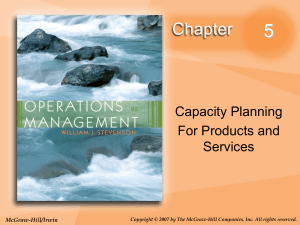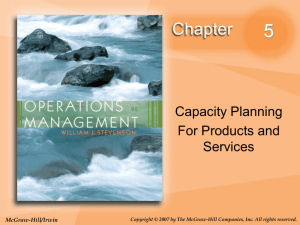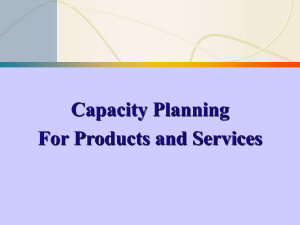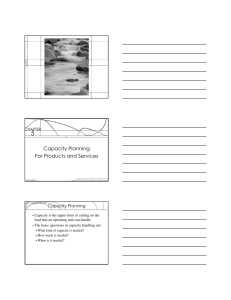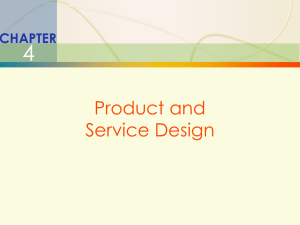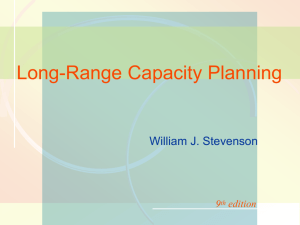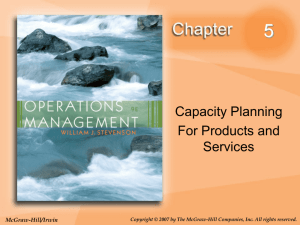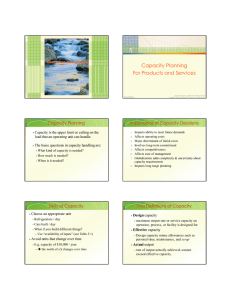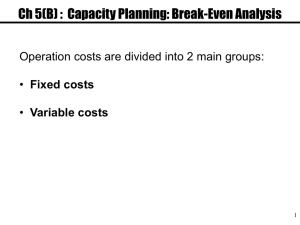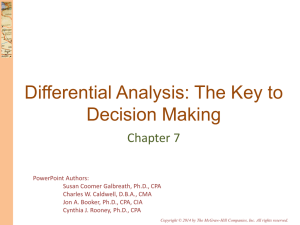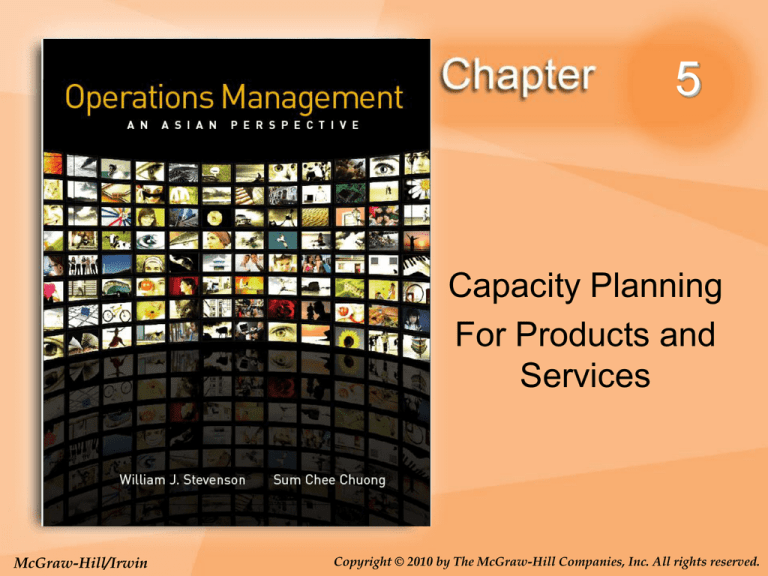
5
Capacity Planning
For Products and
Services
McGraw-Hill/Irwin
Copyright © 2010 by The McGraw-Hill Companies, Inc. All rights reserved.
Learning Objectives
Explain the importance of capacity planning.
Discuss ways of defining and measuring
capacity.
Describe the determinants of effective
capacity.
Discuss the major considerations related to
developing capacity alternatives.
Briefly describe approaches that are useful
for evaluating capacity alternatives
5-2
Capacity Planning
Capacity is the upper limit or ceiling on the
load that an operating unit can handle.
Capacity also includes
Equipment
Space
Employee skills
The basic questions in capacity handling
are:
What kind of capacity is needed?
How much is needed?
When is it needed?
5-3
Importance of Capacity Decisions
1. Impacts ability to meet future demands
2. Affects operating costs
3. Major determinant of initial costs
4. Involves long-term commitment
5. Affects competitiveness
6. Affects ease of management
7. Globalization adds complexity
8. Impacts long range planning
5-4
Capacity
Design capacity
maximum output rate or service capacity an
operation, process, or facility is designed for
Effective capacity
Design capacity minus allowances such as
personal time, maintenance, and scrap
Actual output
rate of output actually achieved—cannot
exceed effective capacity
5-5
Efficiency and Utilization
Actual output
Efficiency =
Effective capacity
Actual output
Utilization =
Design capacity
Both measures expressed as percentages
5-6
Example 1
Design capacity = 50 trucks/day
Effective capacity = 40 trucks/day
Actual output = 36 units/day
Actual output
=
36 units/day
Efficiency =
= 90%
Effective capacity
Utilization =
Actual output
Design capacity
40 units/ day
=
36 units/day
50 units/day
= 72%
5-7
Determinants of
Effective Capacity
Facilities
Product and service factors
Process factors
Human factors
Policy factors
Operational factors
Supply chain factors
External factors
5-8
Key Decisions of
Capacity Planning
1. Amount of capacity needed
Capacity cushion (100% - Utilization)
2. Timing of changes
3. Need to maintain balance
4. Extent of flexibility of facilities
Capacity cushion – extra demand intended to offset uncertainty
5-9
Steps for Capacity Planning
1. Estimate future capacity requirements
2. Evaluate existing capacity
3. Identify alternatives
4. Conduct financial analysis
5. Assess key qualitative issues
6. Select one alternative
7. Implement alternative chosen
8. Monitor results
5-10
Calculating Processing Requirements
(Example 2)
Standard
processing time
per unit (hr.)
Product
Annual
Demand
Processing time
needed (hr.)
#1
400
5.0
2,000
#2
300
8.0
2,400
#3
700
2.0
1,400
5,800
If annual capacity is 2000 hours, then we need three machines to handle the
required volume: 5,800 hours/2,000 hours = 2.90 machines
5-11
In-House or Outsourcing
Outsource: obtain a good or service
from an external provider
1.
2.
3.
4.
5.
6.
Available capacity
Expertise
Quality considerations
Nature of demand
Cost
Risk
5-12
Bottleneck Operation
Figure 5.2
Machine #1
Machine #2
Bottleneck operation: An operation
in a sequence of operations whose
capacity is lower than that of the
other operations
10/hr
10/hr
Machine #3
Bottleneck
Operation
10/hr
Machine #4
10/hr
30/hr
Bottleneck Operation
Bottleneck
Operation 1
20/hr.
Operation 2
10/hr.
Operation 3
15/hr.
10/hr.
Maximum output rate
limited by bottleneck
5-14
Economies of Scale
Economies of scale
If the output rate is less than the optimal level,
increasing output rate results in decreasing
average unit costs
Diseconomies of scale
If the output rate is more than the optimal
level, increasing the output rate results in
increasing average unit costs
5-15
Optimal Rate of Output
Figure 5.4
Average cost per unit
Production units have an optimal rate of output for minimal cost.
Minimum average cost per unit
Minimum
cost
0
Rate of output
5-16
Economies of Scale
Figure 5.5
Average cost per unit
Minimum cost & optimal operating rate are
functions of size of production unit.
0
Small
plant
Medium
plant
Large
plant
Output rate
5-17
Evaluating Alternatives
Cost-volume analysis
Break-even point (BEP)
Financial analysis
Cash flow
Present value
Decision theory
Waiting-line analysis
Simulation
5-18
Cost–Volume Relationships
Amount ($)
Figure 5.6A
Fixed cost (FC)
0
Q (volume in units)
5-19
Cost–Volume Relationships
Amount ($)
Figure 5.6B
0
Q (volume in units)
5-20
Cost–Volume Relationships
Amount ($)
Figure 5.6C
0
BEP units
Q (volume in units)
5-21
Break-Even Problem with Step
Fixed Costs
Figure 5.7A
3 machines
2 machines
1 machine
Quantity
Step fixed costs and variable costs
5-22
Break-Even Problem with Step
Fixed Costs
Figure 5.7B
$
BEP
3
TC
BEP2
TC
3
TC
2
1
Quantity
Multiple break-even points
5-23
Assumptions of
Cost–Volume Analysis
1. One product is involved
2. Everything produced can be sold
3. Variable cost per unit is the same
regardless of volume
4. Fixed costs do not change with volume
5. Revenue per unit is constant with
volume
6. Revenue per unit exceeds variable
cost per unit
5-24


